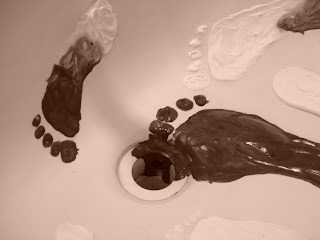
Reading. National Gallery of Art. Consulted October 3rd 2009. Available at: http://www.artinthepicture.com/paintings/Giovanni_Bellini/Saint-Jerome-Reading/
Name: Saint Jerome Reading
Author: Giovanni Bellini. Italian, c. 1430/1435 - 1516
Period: 1505 (Renaissance)
Current location: National Gallery of Art, Washington, DC.
Technique: Oil on panel
Painted surface: 47 x 37.5 cm
The colors are almost all tertiary except the blue used to paint the sky and part of Saint Jerome clothes. The Paleta is warm because most of the colors are like derivate from Yellow. The application is flat because is oil on panel. The composition is unbalanced and that make you pay attention to specifics parts of the painting. The type of line is pictorial. Perspective is by planes, there are 3 different ones: First were Saint Jerome is, second were the rabbit and plants are, and the third is the city on the background. The lighting is constant excepting some shadows on the upper and down left corners. The theme is religious because Jerome is a Saint and is also historical because he was who translated the Bible into Latin. (National Gallery of Art)
What is so special and unique about this work of art?
There are very few paintings of Saint Jerome and in most of them he is painted reading, studying or writing because that is why he is famous for. Also, here Bellini represents the nature by painting water on the bottom and animals on the middle. And of course there is the best Jerome’s friend: The lion.
¿ What was the prevailing atmosphere of the period? What was the cause of it?
This was painted on the Early Renaissance. Many people were interested in the religion because they Church gained a lot of power and influence in the society and it didn’t want people to do research or wonder about the world. The crusades had passed and the ideologist was focus on the human body. ( Frederick Edwords)
What were the predominant political, religious or artistic ideologies?
The humanism was the ideology that predominated in that period. Everyone thought that the human was the center of the Universe. Was the curiosity of learn more about us. They wanted to recreate the style of Rome and Greece. The focus on the perfection of the human body, that’s why there are a lot of naked paintings and sculptures from this period. (Frederick Edwords)
What scientific and technological advances made and impact in the period? In which way?
America was just discovered because of all the navigation technologies such as the compass, ships, astrolabe, sextant… Furthermore, a lot of scientist were making experiments and trying to answer a lot of questions. For example Da Vinci research and made a lot of paintings of the human body and it’s organs.
Is this work of art reflecting the atmosphere of the period? In which way?
Yes it is. The people were curious and remember that Saint Jerome was the first one who translated the Bible in Latin. That represents the open doors of knowledge from everybody (at least Catholics). Also it reflects the interest about the Religion and the Saints, Bible…
Is this work of art reflecting the predominant ideologies of the period? In which way?
The ideology was the perfection of the human body. I think that’s why Bellini painted Saint Jerome with very few clothes. Although Saint Jerome is not nearly the perfect man, they tried to represent the beauty of the best Creation of God: The human.
Is the impact of the scientific and technological advances reflected in this work of art? In which way?
Not at all. Or maybe someone could think that there is represented the printed press invented by Gutemberg in the 14th century. But I don’t think so.
What are the aspects of the period that you identify yourself with? Why?
I really like the idea of appreciate the beauty of the human body, but it shouldn’t be the unique way to see the man, because the most important part of a human is his soul and you can’t represent that. I believe that thinking about us like the most important thing on the Universe is very egoist and in this painting the author painted some animals next to Jerome like the rabbit, a crow and I think a squirrel it’s also there. We could think that these are like some symbols but maybe Bellini just wanted to represent the extensive nature that we have.
Geogrphic location of the origin of the work.

Venetia. Statoveneto. Consulted October 5th 2009. Available at: www.statoveneto.nl/diasporaveneta/venetia_en.htm
Opinion
I very like this picture because the fact that Saint Jerome is painted reading and I am very fond of reading. It is like the door to enter to another world to forget about who you are and where you are and start imagine you as other person, thing, material… I didn’t understand why there was a lion on the lower right corner so I did a little bit of research and I found that is part of a little story. I’ll do a brief for you: One day Saint Jerome was walking to a class and a lion appeared from somewhere and he was the only brave one to approach to him. He realized that he got a spike in his paw and he health it. Since that the lion become Jerome’s friend and they were always together. (Jacobus de Voragine).
I really do like this story. I don’t know if it’s true or false, but I don’t even care. I like the idea that animals could be friends of people and I believe that they have feelings and emotions.
The cave is because many times Jerome lived like a hermit on the mountains, with no one, but his lion.
There are also other animals that make me feel like in balance with the nature. The city on the back is representing the urbanization that didn’t let Jerome concentrate on his reading.
My re-interpretation
The music has been with the human since he appeared on the Earth. When I was looking deeper in the painting I thought that maybe Saint Jerome and his lion would want some relaxing music to concentrate in his studies. So I took my guitar and started trying to translate the atmosphere and the landscape into music. I started with happy melody thinking about the jumping of the rabbit and maybe some nice paragraphs on Jerome’s book. Then I play some thriller because of the raven on the top of the painting which represents the fears and the enemies of Saint Jerome, but he should not be afraid because his friend, the lion, is there to help him in any trouble and here I play some fast rhythms. And after the storm is the calm, where I returned to relaxed melody. And that’s how he lived his days in the mountains, doing it over and over again. Until one day he would finish his book and will return to the city for other one.
Enjoy.
Saint Jerome and his lion by Isaac Aguirre Latabán.
Saint Jerome Reading. Art in the picture. Consulted October 3rd 2009 http://www.artinthepicture.com/paintings/Giovanni_Bellini/Saint-Jerome-Reading/
The Golden Legend. Jacobus de Voragine Consulted October 5th 2009
http://www.fisheaters.com/animals3.html
Saint Jerome Reading. National Gallery of Art. Consulted October 5th 2009
http://www.nga.gov/cgi-bin/pinfo?Object=361+0+none
What is humanism? Frederick Edwords. Consulted October 5th 2009
http://www.jcn.com/humanism.html
Venetia. Statoveneto. Consulted October 5th 2009. Available at: www.statoveneto.nl/diasporaveneta/venetia_en.htm












